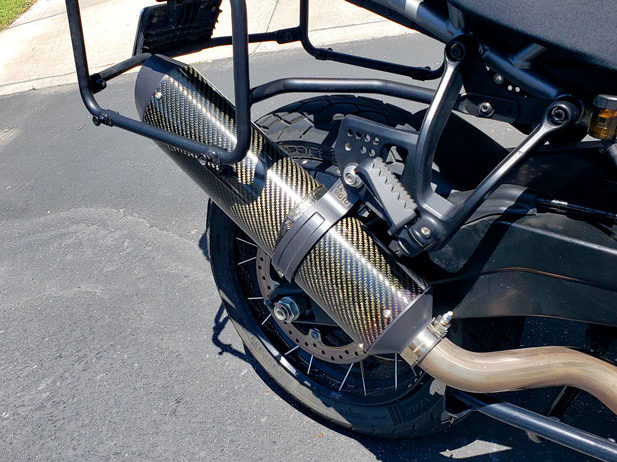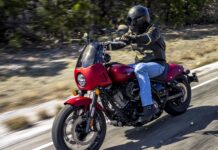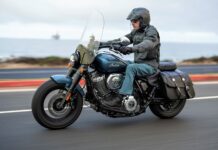
Mufflers. Just the word hints at quieting a loud noise made by a beast or machine.
But in regard to the sound of a V-Twin, stock exhaust systems muffle a little too much. Aftermarket exhaust options enhance the sound of an engine while improving performance and cutting weight relative to stock systems.
My Harley-Davidson Pan America had already been fitted with two aftermarket slip-on mufflers. I had previously installed a Two Brothers muffler, as well as a H-D Screamin’ Eagle can. Now it’s Fuel Moto’s turn, with its Carbon Fiber Slip-On doing a tour of duty.
Related Story: Game Changer!: 2021 Harley-Davidson Pan America 1250 Review
Fuel Moto is well-known among Harley enthusiasts for improving sound, horsepower, and torque on cruisers and touring bikes. This product, made in the USA, is no exception.
The initial installation requires the removal of the stock Harley muffler and resonator with three bolts. The stock catalytic converter stays in place, so the bike remains emissions compliant in all 50 states.
The Fuel Moto muffler comes with an intermediate pipe made of stainless steel that eliminates the OEM resonator box and provides extra ground clearance. Installing the mid-pipe was the only challenge to fitting the system, as it’s a really tight fit. But I warmed it up with a heat gun, and it went on just fine.
The carbon fiber muffler is held in place by a CNC-machined billet aluminum muffler bracket. Inlet and outlet caps feature a black polymer-ceramic Cerakote finish.

The Fuel Moto muffler and intermediate pipe are significantly lighter than the stock pipe, coming in at 8 lbs, 14 oz. That’s 40% lighter than the stock muffler and resonator’s 14 lbs, 11 oz.
Some aftermarket mufflers are far too noisy to be deemed acceptable for a touring bike like mine. The Fuel Moto muffler is barely louder than the Screamin’ Eagle and stock mufflers at idle.
Nevertheless, once you crack the throttle, the sound turns into a serious growl. Once above 5,000 rpm, the growl becomes a roar, and the rider is rewarded with an additional feeling of acceleration. The increase in noise contributes to the perception of speed, and Fuel Moto says its pipe gains 6 hp over the stock exhaust, from 129 hp at the rear wheel to nearly 136 ponies.
On a recent 2,000-mile trip, the muffler produced a light and pleasing sound. My riding partner reported he couldn’t hear it while riding close behind me at highway speeds. I was able to clearly hear my in-helmet headset for communication, as well as music via Bluetooth from my phone. It definitely talks to you as you row through the gears, and I actually enjoy hearing a little extra bark from the engine.
I was initially concerned with the muffler’s straight flow-through design and lack of a spark arrestor. The last thing I wanted was a muffler that would get me a ticket while riding off-road. So, off I went to my local OHV park to find out if the muffler was acceptable. The state park ranger told me that any vehicle with a catalytic converter would be deemed legal for off-road use in state and national forests, so my concerns were put to rest.
The Fuel Moto pipe is made in two lengths. The 12-inch version retails for $699.95, while the 18-incher I tested costs $50 extra. I think it is a worthwhile investment into the aesthetics, weight reduction, and sound of the Pan America, and it’s the best of the four pipes I’ve tested. It’s lighter than stock and the Screamin’ Eagle pipe, and it’s more tolerable on the highway than the boisterous Two Brothers muffler.
All in all, I was very impressed with the Fuel Moto pipe, which rates a solid 9.5 out of 10 for quality and performance compared to all of the mufflers I’ve tested over the past 40 years. The only reason it doesn’t get a perfect 10 is because it lacks adjustability like Supertrapp’s design.
More information at FuelMotoUSA.com.

















